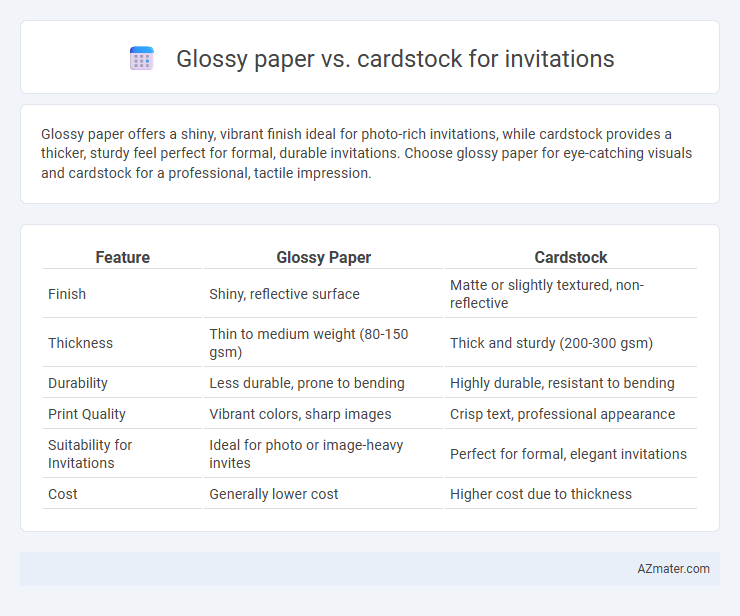Glossy paper offers a shiny, vibrant finish ideal for photo-rich invitations, while cardstock provides a thicker, sturdy feel perfect for formal, durable invitations. Choose glossy paper for eye-catching visuals and cardstock for a professional, tactile impression.
Table of Comparison
| Feature | Glossy Paper | Cardstock |
|---|---|---|
| Finish | Shiny, reflective surface | Matte or slightly textured, non-reflective |
| Thickness | Thin to medium weight (80-150 gsm) | Thick and sturdy (200-300 gsm) |
| Durability | Less durable, prone to bending | Highly durable, resistant to bending |
| Print Quality | Vibrant colors, sharp images | Crisp text, professional appearance |
| Suitability for Invitations | Ideal for photo or image-heavy invites | Perfect for formal, elegant invitations |
| Cost | Generally lower cost | Higher cost due to thickness |
Introduction to Invitation Paper Choices
Glossy paper offers a smooth, shiny finish that enhances color vibrancy and creates a polished look for invitations, making images and graphics stand out. Cardstock provides a thicker, sturdier feel with a matte or textured surface, adding durability and an elegant touch favored for formal events. Choosing between glossy paper and cardstock depends on the desired aesthetic and the impression you want your invitation to convey.
What is Glossy Paper?
Glossy paper is a smooth, shiny paper coated with a glossy finish that enhances color vibrancy and sharpness, making it ideal for invitations featuring rich graphics or photographs. Its reflective surface offers a polished, professional look but can be prone to fingerprints and smudges. Compared to cardstock, glossy paper tends to be thinner and less sturdy, focusing more on visual appeal than durability for invitation cards.
What is Cardstock?
Cardstock is a thick, durable paper choice ideal for invitations due to its sturdiness and premium feel, typically ranging from 80 to 110 lbs in weight. Unlike glossy paper, which has a smooth, shiny finish designed to enhance images, cardstock offers a matte or slightly textured surface that is better suited for writing or printing intricate designs. Its rigidity ensures invitations maintain their shape and stand out, making cardstock a preferred option for formal events like weddings and corporate gatherings.
Visual Appeal: Glossy vs Cardstock
Glossy paper offers a vibrant, reflective finish that enhances color intensity and sharpness, making images and text pop with a polished look ideal for eye-catching invitations. Cardstock provides a matte or textured surface with a thicker, sturdier feel that conveys elegance and durability, lending invitations a classic and sophisticated appeal. The choice between glossy and cardstock directly impacts visual appeal by balancing brightness and tactile quality to suit the invitation's style and occasion.
Durability and Feel
Glossy paper offers a smooth, shiny finish that enhances color vibrancy but tends to be less durable and more prone to fingerprints and scratches when used for invitations. Cardstock provides superior durability with a thicker, sturdier feel, making it ideal for invitations that need to withstand handling and mailing. For invitations emphasizing longevity and a premium tactile experience, cardstock is the preferred choice over glossy paper.
Printing Quality Comparison
Glossy paper offers a vibrant, high-shine finish that enhances color depth and sharpness, making images on invitations appear more vivid and eye-catching compared to cardstock. Cardstock provides a matte or textured surface that absorbs ink differently, resulting in a more muted and elegant look but less color intensity than glossy finishes. For invitations requiring crisp, bold graphics and rich color saturation, glossy paper outperforms cardstock in printing quality, while cardstock excels in durability and tactile appeal.
Cost Comparison
Glossy paper for invitations generally costs less per sheet than cardstock, making it a budget-friendly option for large quantities. Cardstock, known for its thicker and more durable quality, typically carries a higher price point due to its premium weight and texture. Choosing between glossy paper and cardstock ultimately depends on balancing the desired aesthetic and sturdiness against the overall budget constraints.
Best Occasions for Glossy Invitations
Glossy paper excels for wedding invitations, birthday parties, and corporate events due to its vibrant colors and smooth finish that enhance photo quality and intricate designs. Its reflective surface highlights fine details, making it ideal for formal occasions where elegance and visual impact are paramount. Glossy invitations work best in well-lit environments, ensuring guests appreciate the vivid imagery and crisp text.
Best Occasions for Cardstock Invitations
Cardstock invitations are ideal for formal events such as weddings, milestone birthdays, and corporate gatherings due to their sturdy feel and professional appearance. Their thick, durable texture adds a premium touch that enhances the tactile experience and complements intricate designs or embossed details. Cardstock is also perfect for occasions requiring lasting keepsakes, ensuring invitations remain pristine as cherished mementos.
Choosing the Right Paper for Your Invitations
Glossy paper enhances invitations with a vibrant, shiny finish, making colors pop and images appear sharper, ideal for photo-centric designs or modern themes. Cardstock offers durability and a sturdy feel, providing an elegant, professional appearance perfect for formal events like weddings or corporate gatherings. Selecting between glossy paper and cardstock hinges on the desired aesthetic, event tone, and budget considerations to ensure invitations make a lasting impression.

Infographic: Glossy paper vs Cardstock for Invitation
 azmater.com
azmater.com